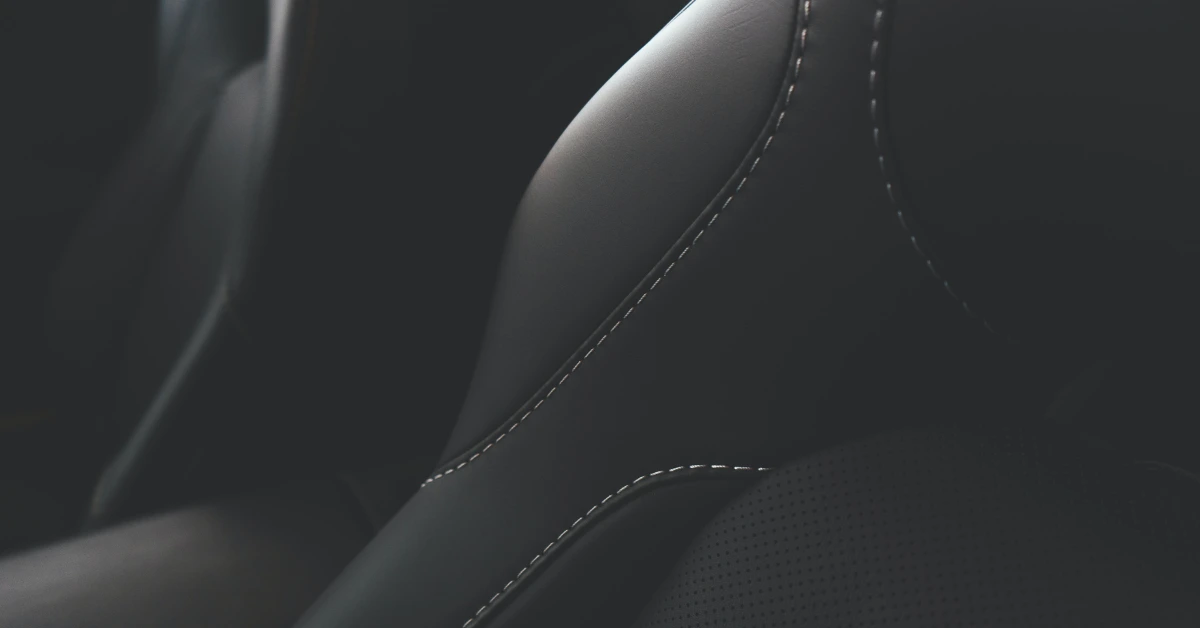Car leather cleaning is an essential aspect of vehicle maintenance that can make a significant difference in preserving the luxurious appearance and comfort of your car’s interior.
A clean leather interior not only improves the overall aesthetics but also extends the life of the material, ensuring that it remains soft and supple. In addition, proper care can help prevent damage from the sun’s rays, extreme temperatures, and other environmental factors that can cause premature aging or fading. So, I think that were enough reasons for a good car leather cleaning – Let’s go!

Understanding Leather Care
Car leather cleaning is an essential aspect of maintaining your vehicle’s interior. By taking care of your leather seats, you’ll ensure they stay vibrant, smooth, and comfortable for years. Following, we’ll go through different types of car leather, and also discuss the leather aging process to help you get a better understanding of the leather care process.
Types of Car Leather
There are three primary types of car leather that you might encounter in a vehicle’s interior:
- Aniline Leather: The most natural and luxurious type, aniline leather is soft and supple. It is dyed without the use of pigments, leaving the natural markings of the hide visible. This type of leather requires special care, as it is more susceptible to stains and damage.
- Semi-Aniline Leather: A balance between durability and luxury, semi-aniline leather is partially dyed with pigments and then sealed with a protective coating. It retains some natural characteristics while being more resistant to wear and stains compared to aniline leather.
- Pigmented Leather: The most durable and low-maintenance option, pigmented leather is dyed and sealed with a pigmented coating. This type of leather is commonly found in car interiors due to its resistance to stains and wear.
Leather Aging Process
Car leather undergoes an aging process that, without proper care, can lead to cracking, fading, and general wear. The aging process consists of several factors:
- Daily wear and tear: Regular use of the car seats can stress the leather, causing minor scratches and abrasions.
- UV exposure: Prolonged exposure to sunlight can cause the leather’s color to fade and dry out, making it more prone to cracks.
- Temperature changes: Extreme temperature fluctuations can cause the leather to expand and contract, leading to cracks and other types of damage.
- Spills and stains: Untreated spills can result in permanent stains and discoloration of the leather surface.
When Car Leather cleaning and conditioning is done regulary to your car’s seats, you can prevent or minimize the effects of these aging factors, keeping your leather looking and feeling its best for years to come.
Routine Car Leather Cleaning
Car leather cleaning is an important task every car owner should keep in mind to maintain the look and longevity of their vehicle’s interior. In this section, we will discuss the process of routine car leather cleaning by focusing on gathering the necessary supplies and then providing a step-by-step cleaning guide.
Gathering Your Supplies
Items to buy
- Car Leather Cleaner: A dedicated car leather cleaner specifically formulated for automotive leather is recommended.
- Soft microfiber cloth: To avoid scratching the leather surface while cleaning.
- Soft brush: A soft-bristle brush to work the cleaner into the leather without causing damage.
- Water: To dampen the cloth or for light surface cleaning.
- Sealant or conditioner: For a finishing touch, choose a sealant for newer coated leather or a conditioner for older leather.
Step-by-Step Cleaning Guide
Step-by-step
- Vacuum the seats: Begin by vacuuming the leather seats to remove any loose debris.
- Dampen the cloth: Wet your microfiber cloth with a small amount of water. It should be damp but not soaked.
- Apply car leather cleaner: Put a small amount of car leather cleaner onto the damp cloth.
- Test a small area: Test the cleaner on a small, inconspicuous section of the leather. If there is no adverse reaction, proceed to the next step.
- Clean the surface: Gently rub the cloth onto the leather surface, working the cleaner in a circular motion. Use the soft-bristle brush to help work the cleaner into the leather, being mindful not to damage the surface.
- Wipe away excess cleaner: After working the cleaner evenly, use a clean, damp microfiber cloth to wipe away any excess cleaner.
- Dry the leather: Use a dry microfiber cloth to dry the leather surface gently.
- Apply sealant or conditioner: Depending on your car’s leather type, apply either a sealant for newer coated leather or a conditioner for older leather by following the manufacturer’s instructions.
- Buff the leather: Once the sealant or conditioner has been applied, use a clean, dry microfiber cloth to gently buff the leather surface in a circular motion, restoring its natural shine.
By following these steps, you can keep your car’s leather interior in excellent condition for years to come. Regular car leather cleaning not only maintains the appearance of your vehicle but also helps to preserve the value of your investment.
Deep Cleaning Techniques
Car leather cleaning is essential to keep your vehicle’s interior looking fresh and well-maintained. Next, we’ll explore some deep cleaning techniques that help you handle stubborn stains and keep your leather seats in top condition.

Stain Removal Tips
Step-by-step
- Identify the stain: Determine the type of stain you’re dealing with (e.g., ink, grease, food, etc.) to choose the appropriate cleaning solution.
- Spot test: Always test your cleaning solution on a small, inconspicuous area of the leather before applying it to the stain.
- Blot, don’t rub: Use a clean, soft cloth to gently blot the stain, avoiding rubbing or scrubbing, which could harm the leather.
- Use a gentle cleaner: Opt for a leather-specific cleaning product or a mild solution of warm water and mild soap.
- Work in sections: Clean a small area at a time, and frequently replace your cloth with a clean one to prevent spreading the stain.
- Dry thoroughly: After cleaning, use a dry cloth to remove excess moisture and let the area air dry completely.
Conditioning After Cleaning
Step-by-step
- Choose a leather conditioner: Look for a quality leather conditioner specifically designed for automotive use.
- Spot test: Similar to cleaning, test the conditioner on a small, hidden area of the leather to ensure it doesn’t cause discoloration or other adverse effects.
- Apply conditioner sparingly: Using a clean, soft cloth, gently rub the conditioner into the leather using a circular motion. Avoid applying too much, as it could make the seats excessively slippery.
- Allow it to absorb: Give the conditioner time to be absorbed by the leather; waiting at least 30 minutes is recommended.
- Buff and wipe away excess: After the conditioner has been absorbed, use a clean cloth to buff the leather and remove any excess product.
By following these deep car leather cleaning techniques, you can ensure your car’s leather interior remains well-maintained and looking pristine for years to come.
Preventing Leather Damage
Car leather cleaning is essential for maintaining a nice and shiny interior. In this section we’ll discuss various ways to prevent leather damage and ensure your car’s interior stays in top condition.
Protective Measures
Proper cleaning products: Using a dedicated car leather cleaner specifically designed for car interiors is the first step towards protecting your leather seats. Avoid using harsh chemicals or abrasive materials, which can cause damage and discoloration.
Sealant application: Most leather in newer cars is coated, so applying a sealant can help protect the finish. This creates a barrier that shields the leather from dirt, spills, and other elements that can cause damage.
Avoid direct sunlight: Prolonged exposure to sunlight can cause leather to fade and become dry. Try parking in the shade when possible or use window tint or sunshades to minimize UV damage.

Regular Maintenance Schedule
- Regular Cleaning: Clean your leather seats every few months or more frequently if they are subjected to heavy use. Follow the proper method to clean leather by not scrubbing aggressively and using a soft cloth, sponge, or leather brush.
- Conditioning: Conditioning your leather seats is crucial for preserving the finish and preventing them from becoming dry or brittle. Use a high-quality leather conditioner and follow the product’s recommendations for the application process.
- Inspect for damages: Regularly inspect the leather for potential wear, scratches, or other damages. Addressing these issues early on can help prevent further deterioration.
Set a regular maintenance schedule and you can keep your car’s leather interior looking its best and avoid potential damage.
Professional Leather Cleaning Services
Car leather cleaning is a crucial aspect of maintaining your vehicle’s interior. With the right care and products, the luxurious look and feel of leather seats can last for years. Professional leather cleaning services cater to this need and provide exceptional results that are difficult to achieve with DIY methods.
There are several reputable car leather cleaning services available for car owners. One of the best, Ram Leather Care, a company that specializes in leather, fur, and textile garments. They offer personalized leather and specialty cleaning services to clients all over the United States. Most Clients left happily.
If you’re looking for car upholstery cleaning services in your area, Yelp can be a helpful resource. You can find local businesses with a track record of offering high-quality cleaning for car interiors. Make sure to read the reviews and opinions from other customers before choosing a service provider.
Here are a few quick tips for maintaining your car’s leather:
- Vacuum regularly: Remove dust and debris from the leather surfaces using a vacuum cleaner with a soft brush attachment.
- Clean spills immediately: Wipe off any spills with a soft, absorbent cloth to prevent staining.
- Avoid direct sunlight: Prolonged exposure to sunlight can cause your leather seats to fade and crack. Use sunshades or park in a shaded area when possible.
- Condition at least twice a year: Use a high-quality conditioner to keep your leather seats soft and supple.

Investing in professional car leather cleaning services can help maintain the luxurious appearance of your car’s interior. By combining these services with proper care and maintenance, you can extend the life of your leather seats and enjoy a comfortable, clean driving experience.
FAQ
What is the best way to clean leather in your car?
You can use a commercial leather cleaner, or you can make your own. Mix warm water and Castile soap or liquid dish washing soap together in a bucket. Use a ratio of 5 parts water to 1 part soap. Dampen a cloth with the solution and wipe down the seat surfaces.
Can I clean car leather with water?
How to Clean Leather Car Seats. The first step to cleaning your leather car seat is using soap and warm water. Using warm water and a suitable leather cleaner, soap wet down the satin or microfiber cloth with warm water, then use it to lightly scrub away some of the dirt that has collected on your seat.
How often should I clean leather car seats?
To retain this luxurious look, it is best practice to clean and condition your leather seats every two to three months. While it is best practice to clean your leather seats regularly, it is easy to get it wrong. You do not want to damage your beautiful leather by using the wrong cleaning agent or cleaning tool.
We´ll hope to brought a little useful knowledge with our Car Leather Cleaning Article to you – did you made already experiences with cleaning your Cars Leather?
If so, or in any other way feel free to Contact us and maybe let us know if you missed something.
See you next time when it says…
…”Let´s Ride!”






